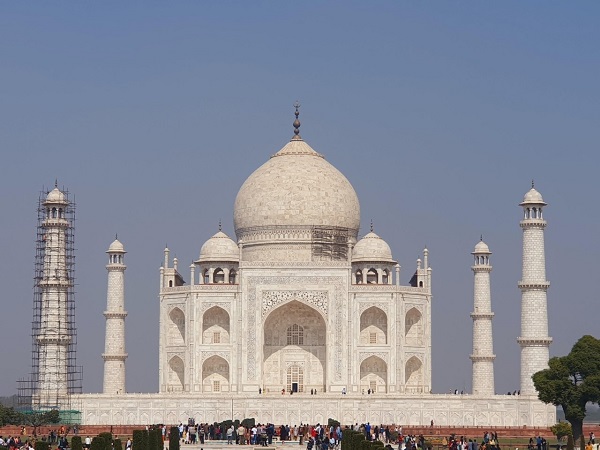Agra, (Asian independent) India’s star tourism destination Agra has suffered the most under the ‘double-engine government’ that flaunts its saffron colours unabashedly, perhaps because of the perceived pro-Islamic character of the city, founded by Sikandar Lodhi in 1504.
This is the consensus of opinion in the city of heritage monuments that has nine BJP legislators and three MPs. Names of streets have been changed and statues of new heroes are being pompously installed to correct historical distortions. But basic problems of the city continue to hang fire for want of political will.
“It is still possible that the BJP may comfortably romp home in the coming Uttar Pradesh Assembly elections, but that would be largely due to absence of credible alternative,” says political commentator Paras Nath.
After spending several crores of rupees to draw up vision documents to declare Agra as a heritage city, at the call of the apex court, the state government midway decided to project the Mughal metropolis as a smart city.
From heritage to smart city is a sordid saga of corruption, adhocism, lack of understanding and prejudiced mindset, allege the striking lawyers who have been protesting for a high court bench for last four decades. Former Uttar Pradesh Chief Minister Akhilesh Yadav had spent Rs 140 crore on developing a cycle track from Etawah to Agra through ravines, forests and adventurous terrains, but today it lies in a state of shambles, almost disappeared.
Another mega project of the previous Samajwadi Party government, the Rs 150-crore Mughal museum near the Taj Mahal has seen only one change, and that of nomenclature, now called as Chhatrapati Shivaji museum. No one knows when it will be opened.
Much before plans for opening Jewar airport, Agra was promised an International airport but the Yogi Adityanath government has clearly shelved the project except changing the name of a bus stand like airport, from Kheria to Deen Dayal airport. A new terminal building has taken ages to complete a boundary wall.
“They ( BJP government) wanted a showpiece in Varanasi, did it in two years, but obviously Agra is not their favourite, for whatever reasons,” laments Sudhir Gupta, a senior citizen.
Agra’s health infrastructure is not their concern, the Agra University can go to dogs. Tourism and other industries can be allowed to suffer due to all kinds of restrictions in the eco-sensitive Taj Trapezium Zone. Indeed the list of grievances is long, but the most glaring shortcoming has been the continued neglect of river Yamuna, now reduced to a vast sewage canal.
Ever since the Supreme Court took up the PIL of M.C. Mehta on pollution threats to Taj Mahal in 1993, thousands of crores of rupees have been spent in the Taj Trapezium Zone on controlling pollution, but the results are invisible to naked eye.
For months together the city has remained in the red zone, with the ambient air becoming highly toxic and polluted. In the list released by the Central Pollution Control Board, Agra’s AQI index was 327, with dust level (suspended particulate matter, SPM), PM 2.5 and carbon monoxide levels shooting up beyond tolerable limits.
The Uttar Pradesh Pollution Control Board (UPPCB) routinely sends out notices to a number of agencies, including the Metro Corporation, the UP Jal Nigam, the Smart City company and the Agra Development Authority, directing them to follow the guidelines to bring down the pollution levels.
Vishwanath Sharma, UPPCB Regional Officer, says action would soon follow against those found responsible for adding to the pollution load in the city. Close to the Taj Mahal, pollution level was found alarmingly high.
Local green activists blame the state government agencies which had dug up the whole city for various developmental projects. The National Highway Authority, too, has been accused of not promptly attending to calls for repairing roads of the three national highways that criss-cross the city. Work on the Agra Metro in the vicinity of the Taj Mahal has also added to the pollution load, Environmentalist Devashish Bhattacharya said.
Clearly, in the city of monuments, Prime Minister Narendra Modi’s ‘Swachch Bharat Abhiyan’ (Clean India Mission) appears to have run aground and made no discernible change to the city’s profile or the upkeep of basic amenities, according to the locals, though the Mayor and other officials of the Agra Municipal Corporation dismiss the concerns raised.
“The reason why the city remains so dirty and disorganised is because of the misplaced priorities of the government.”
“The officials spend more time on organising fairs and festivals than on getting the basics fixed, feel members of the River Connect Campaign. Cleaning up the city and streamling the traffic management plan or improving the law and order situation are nowhere on the priority list,” the locals said.
Local politicians have no role to play in cleaning up the city or the Yamuna river. On paper, public toilets have been opened but in large parts of the city, people still defecate in the open, along the drains.
“As you enter the city, a strange stink or odour hits you and never quits your company till you leave the city.”
“Elsewhere they (government) roll out a red carpet for guests. In Agra you have animal dung splashed on roads and a stink in the air welcoming people.”
“Little wonder no one wants to stay back for the night in Agra,” says Surendra Sharma, President of the Braj Mandal Heritage Conservation Society.
Agra’s past haunts it’s future. Now residents are suggesting change of name, perhaps Agrasen Nagar, to secure favourable response from Chief Minister Yogi Adityanath.








